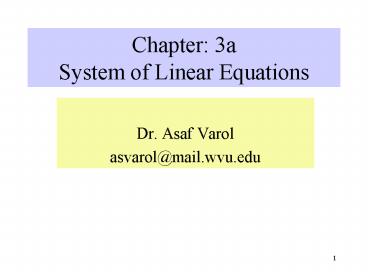Chapter: 3a System of Linear Equations PowerPoint PPT Presentation
1 / 28
Title: Chapter: 3a System of Linear Equations
1
Chapter 3aSystem of Linear Equations
- Dr. Asaf Varol
- asvarol_at_mail.wvu.edu
2
Introduction (I)
- Linear Equation an equations where only the
first exponent of the unknown is present - System of Linear Equations the set of linear
equations where there are more than one unknown
3
Introduction (II)
4
Introduction Example - Vibration of Three
Railroad Cars
5
Introduction Example - Vibration of Three
Railroad Cars
6
Introduction Example - Forces Acting on a Simple
Truss
7
Introduction Example - Forces Acting on a Simple
Truss
8
Introduction Example - Forces Acting on a Simple
Truss
9
Review of Matrix Algebra
10
Review of Matrix Algebra - Addition
11
Review of Matrix Algebra - Multiplication
12
Example E3.2.1
13
Transpose and Determinant of a Matrix
14
Example E3.2.2 - Find the Determinant of a Matrix
15
Identity Matrix and the Inverse of a Matrix
16
Inverse of a matrix
17
Inverse of a matrix (Contd)
18
Rules Governing Matrix Algebra
19
Matrix Norms
20
Matrix Norms (II)
21
Example E3.2.3
22
Condition Number and Ill-Conditioned Systems
The condition number of a matrix, A. is defined
by Cond(A) where the symbol
indicates any norm of the matrix. It can be shown
by matrix algebra, that the condition number of a
matrix is always greater than or equal to one.,
i.e. Cond (A) If the condition number
of a matrix is large it is said to be
ill-conditioned. Systems of equations that
involve ill-conditioned matrices are difficult to
solve. These systems must be first preconditioned
before attempting to find a numerical solution.
How large should the condition number be before
one can call a matrix truly ill-conditioned is a
matter of order of magnitudes. For
ill-conditioned systems, a small change in
coefficients leads to large changes in the
solution.
23
Example E3.3.1
ProblemFind the condition number of the
following matrix A A-1 (1/56)
Solution Using the uniform matrix norm
Max (4, 7, 12) 12
Max(1/56) (36, 24, 18) 36/56 9/14 Cond
(A) (12)(9/14) 54/7 Using the Column
norm Max (6, 9, 8) 9
Max(1/56) (40, 24, 14) 40/56 5/7 Cond
(A) (9)(5/7) 45/7
24
Rules of Thumb for Checking the Condition of a
Matrix
Apply the following tests after scaling (or
normalizing) the matrix, A, such that the
largest element in each row is one. (i) If
the sum of the absolute value of off-diagonal
elements is less than the absolute value of the
diagonal element for each row separately, this
matrix is most likely to be well-conditioned.
Note that interchanging the rows, i.e. partial
pivoting, does not improve the condition number
of a matrix. (ii) If detA ? 0. This matrix
is ill-conditioned. (iii) If there are
elements of A-1 which are several order of
magnitude larger than one, it is most likely that
this matrix is ill-conditioned. (iv) Let I
A A-1 if I is significantly different
(i.e. the diagonal elements are not close to one)
than the identity matrix, I, then the matrix
A is likely to be ill-conditioned. (v) Let
A A-1-1 if A is not close to the
original matrix A the matrix is most likely to
be ill-conditioned.
25
Example E3.3.2
Problem Given the following Show that the
condition number of the matrix does not change
when the rows are interchanged. Solution No
w interchange the rows to obtain One can
show that the inverse of the matrices are right
by checking if the product BB-1 I is
satisfied. Using the Froberius norm we
find cond(A) AeA-1e
(1.4177)(1.4177) 2.001 cond(B)
BeB-1e (1.4177)(1.4177) 2.001
26
Direct Methods for Solving Linear Systems
Survey of several commonly used direct methods
meaning that when the outlined procedure or
(algorithm) is completed we get the solution,
hence there is no need for iteration to improve
an approximate solution. Cramers
Method This method is the oldest but the most
cumbersome and expensive method to solve a given
system of linear equations. It requires
computation of (n1) determinants of nxn
matrices, where n is the number of unknowns. The
rule is given by xi detA/detA for
i1,2,3,...,n (3.4.1) where A is the
modified matrix where the ith column is
replaced by the right hand side of the equations,
i.e. by cT (c1,c2,c3, ...
27
Example E3.4.1
Problem Find the solution of the system of
equations given by Equation (3.1.4). Solution
First we write the equations in matrix form
AXC and observe that x1 a0
detA1/detA x2 a1 detA2/detA
x3 a2 detA3/detA where It
follows then detA 6 a0 8/6 a1 3/6 a2
-5/6
28
References
- Celik, Ismail, B., Introductory Numerical
Methods for Engineering Applications, Ararat
Books Publishing, LCC., Morgantown, 2001 - Fausett, Laurene, V. Numerical Methods,
Algorithms and Applications, Prentice Hall, 2003
by Pearson Education, Inc., Upper Saddle River,
NJ 07458 - Rao, Singiresu, S., Applied Numerical Methods
for Engineers and Scientists, 2002 Prentice Hall,
Upper Saddle River, NJ 07458 - Mathews, John, H. Fink, Kurtis, D., Numerical
Methods Using MATLAB Fourth Edition, 2004
Prentice Hall, Upper Saddle River, NJ 07458 - Varol, A., Sayisal Analiz (Numerical Analysis),
in Turkish, Course notes, Firat University, 2001 - http//math.uww.edu/faculty/mcfarlat/inverse.htm

